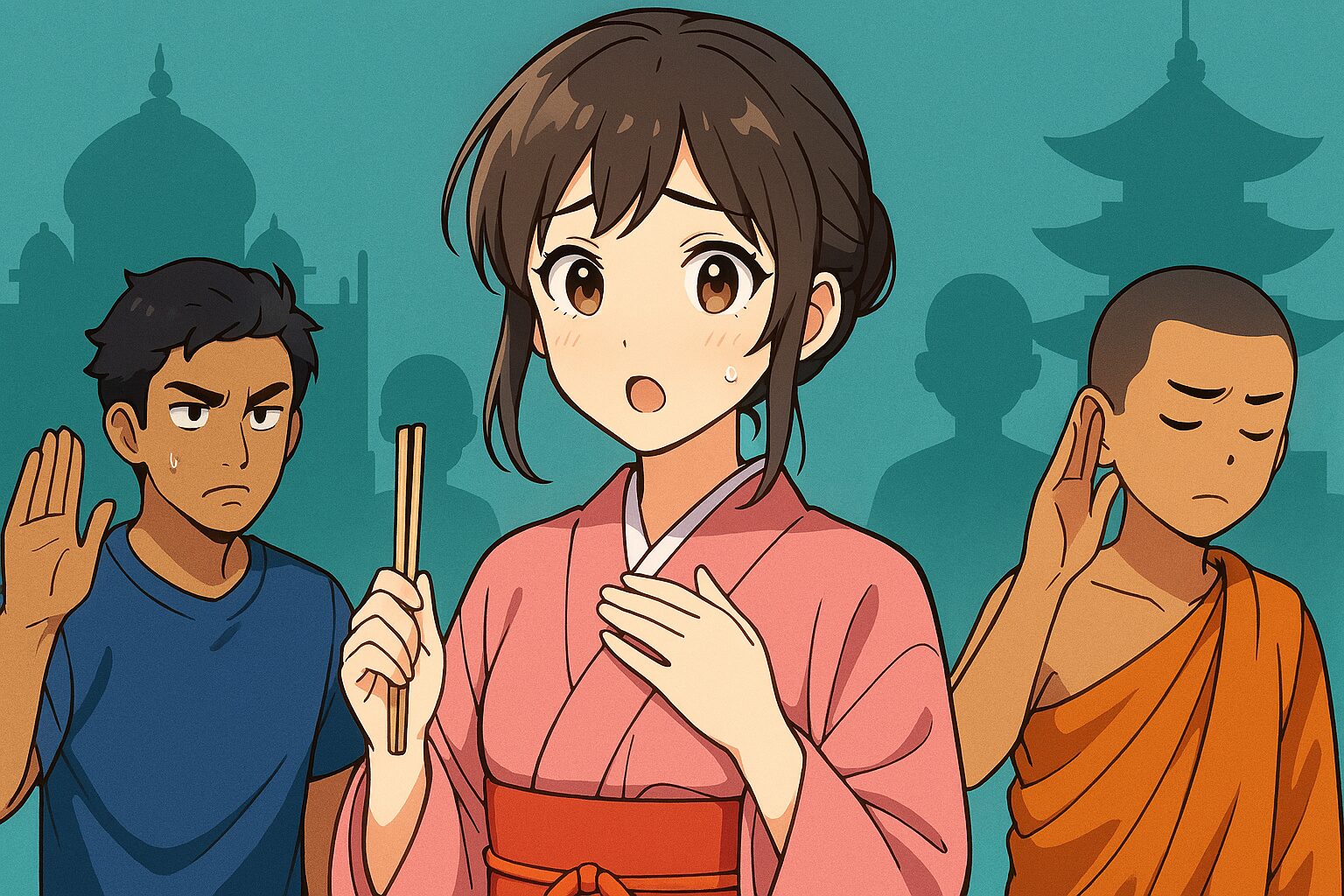- Introduction: What Is a Taboo?
- 🌍 Global Taboos: Surprising Customs Around the World
- 🗾 Japanese Taboos: Silence, Cleanliness, and Invisible Boundaries
- 🌐 Taboos Are Stories, Not Just Rules
- 💬 For Visitors: How to Approach Japanese Taboos
- 🧭 Beyond Taboos: A Journey into Cultural Wisdom
- 📚 Taboos in Modern Life: What Changes, What Endures
- 📝 Conclusion: Taboos Are Cultural Poetry
- 🔗 References & Further Reading
- はじめに:タブーとは何か?
- 🌍 世界のタブー:文化の違いが生む驚きと敬意
- 🗾 日本のタブー:静けさと美意識に根ざした「してはいけないこと」
- 🌐 タブーは「違い」ではなく「物語」
- 💬 海外の方へ:日本のタブーをどう受け止めるか
- 🧭 タブーを越えて:文化理解の旅へ
- 📚 タブーと現代社会:変わるもの、変わらないもの
- 📝 まとめ:タブーは文化の詩である
- 🔗 関連リンク・参考資料
Introduction: What Is a Taboo?
The word “taboo” originates from the Polynesian term tapu, meaning “sacred” or “forbidden.” Today, it refers to actions or behaviors that are socially or culturally unacceptable, often rooted in religion, tradition, or shared values.
But taboos are more than just rules—they’re stories. They reflect what a society holds dear, what it fears, and how it expresses respect. In this article, we’ll explore surprising taboos from around the world and dive deep into the uniquely subtle taboos of Japan.
🌍 Global Taboos: Surprising Customs Around the World
🇹🇭 Thailand: Don’t Touch a Child’s Head
In Thailand, the head is considered sacred—the seat of the soul. Touching someone’s head, even affectionately, is seen as disrespectful. This belief is deeply rooted in Buddhist values and social hierarchy.
Learn more about Thai etiquette
🇮🇳 India: Don’t Eat with Your Left Hand
In India, the left hand is traditionally viewed as unclean. Eating, greeting, or giving items with the left hand is considered impolite. This stems from Hindu concepts of purity and ritual cleanliness.
Why Indians eat with their hands
🕌 Middle East: Don’t Show the Soles of Your Shoes
In many Islamic cultures, showing the soles of your shoes is a grave insult. Shoes are associated with dirt, and exposing them to others—especially in formal settings—is seen as highly disrespectful.
🗾 Japanese Taboos: Silence, Cleanliness, and Invisible Boundaries
🍚 Chopstick Taboos
- Standing chopsticks upright in food: This resembles a funeral ritual involving rice and incense, and is considered ominous.
- Passing food from chopstick to chopstick: This mimics the handling of bones during cremation ceremonies and is strictly avoided.
👟 Wearing Shoes Indoors
In Japan, removing shoes before entering a home or certain indoor spaces is a sign of respect and cleanliness. The threshold between outside and inside is symbolic—a boundary between the impure and the sacred.
Why do Japanese people take off their shoes?
📵 Talking Loudly on Trains
Japanese trains are famously quiet. Speaking loudly or talking on the phone is frowned upon. This reflects a cultural emphasis on harmony, empathy, and not disturbing others in shared spaces.
Why are Japanese trains so quiet?
🙇♂️ Bowing Incorrectly
Bowing is a nuanced form of nonverbal communication in Japan. The angle and timing matter—a shallow bow may be casual, while a deep bow expresses deep respect or apology. Misusing it can unintentionally offend.
🌐 Taboos Are Stories, Not Just Rules
Every taboo tells a story. In India, eating with the right hand honors purity. In Thailand, avoiding the head shows reverence for the soul. In Japan, silence and subtle gestures reflect a deep respect for others and the shared environment.
Understanding taboos helps us move beyond stereotypes and into empathy. It’s not about avoiding mistakes—it’s about learning the values that shape behavior.
💬 For Visitors: How to Approach Japanese Taboos
Many foreign visitors unknowingly break taboos in Japan. But these moments are often met with patience and understanding. What matters most is the willingness to learn and show respect.
In Japan, “reading the air”—sensing unspoken social cues—is key. It may seem vague, but it’s a powerful form of emotional intelligence. By observing and adapting, visitors can build genuine cultural bridges.
🧭 Beyond Taboos: A Journey into Cultural Wisdom
Taboos aren’t just restrictions—they’re reflections of what a culture treasures. They evolve over time, yet some remain timeless. In Japan, the quiet of a train or the ritual of removing shoes continues to express values that transcend generations.
📚 Taboos in Modern Life: What Changes, What Endures
Some taboos fade with time. Others persist. For example, gender roles around bathing order or handedness have relaxed in Japan. But funeral-related etiquette, public silence, and spatial boundaries remain deeply respected.
Taboos are living values—not fossils. They adapt, but they still guide behavior and express identity.
📝 Conclusion: Taboos Are Cultural Poetry
Taboos are unwritten poems. They speak of reverence, restraint, and the invisible threads that bind people together. In Japan, they reflect a quiet philosophy—one that values harmony, subtlety, and shared space.
By comparing global taboos with Japanese ones, we don’t just learn what not to do—we learn how to see the world through another’s eyes.
🔗 References & Further Reading
- Japan National Tourism Organization (JNTO)
- Thai etiquette and personal space
- Indian eating customs and hand etiquette
- Why are Japanese trains so quiet?
- Why do Japanese people bow?
- Why do Japanese people take off their shoes?
世界のタブーと日本のタブー:文化の違いが生む「してはいけないこと」の物語
はじめに:タブーとは何か?
「タブー(Taboo)」とは、ある文化や社会において「してはいけない」とされる行為や言葉のこと。宗教的な戒律から、日常のマナーまで、その内容は国や地域によって大きく異なります。
この記事では、世界各地の代表的なタブーを紹介しながら、日本独自のタブーについても深掘りしていきます。海外の方にもわかりやすく、日本文化の繊細さと奥深さを伝える旅へご案内します。
🌍 世界のタブー:文化の違いが生む驚きと敬意
🇹🇭 タイ:子供の頭に触れるのはNG
タイでは、頭は「魂が宿る神聖な場所」とされており、他人の頭に触れることは極めて失礼な行為とされています。
🇮🇳 インド:左手で食事をするのはNG
インドでは、左手は「不浄の手」とされており、食事や握手などの場面では右手を使うのがマナーです。
🕌 中東諸国:靴の裏を見せるのはNG
イスラム圏では、靴の裏を人に向けることは極めて無礼とされます。これは「汚れたものを見せる」という意味合いがあり、宗教的にも社会的にも避けるべき行為です。
🗾 日本のタブー:静けさと美意識に根ざした「してはいけないこと」
🍚 箸の使い方にまつわるタブー
- 刺し箸:食べ物に箸を突き刺す行為は、葬儀の枕団子に箸を立てる習慣を連想させ、不吉とされます。
- 箸渡し:箸から箸へ食べ物を渡すのは、火葬後の遺骨を拾う儀式を思わせるため、絶対に避けるべきです。
👟 靴を履いたまま室内に入る
日本では玄関で靴を脱ぐのが基本。これは清潔さだけでなく、空間への敬意を表す行為でもあります。
📵 電車内での通話や大声
公共の場では「他人に迷惑をかけない」ことが美徳とされ、静かに過ごすのがマナーです。
🙇♂️ お辞儀の角度とタイミング
お辞儀は日本文化の象徴とも言える礼儀作法。角度やタイミングを誤ると失礼になることもあります。
🌐 タブーは「違い」ではなく「物語」
タブーは単なる禁止事項ではなく、その国の歴史、宗教、価値観、美意識が凝縮された文化の物語です。違いを知ることで、共感と理解が生まれます。
💬 海外の方へ:日本のタブーをどう受け止めるか
タブーを知らずに失礼な行為をしてしまうこともありますが、それは悪意ではなく文化の違いから生まれるもの。日本人はそうした違いに寛容であり、理解しようとする姿勢を歓迎します。
🧭 タブーを越えて:文化理解の旅へ
タブーを知ることは、異なる文化の中にある「価値観の地層」を掘り起こす行為です。違いの中にある物語に耳を傾けることで、より深い理解と友情が生まれます。
📚 タブーと現代社会:変わるもの、変わらないもの
時代とともに変化するタブーもあれば、変わらず守られているものもあります。それぞれが文化の「生きた価値観」として、私たちの暮らしに息づいています。
📝 まとめ:タブーは文化の詩である
タブーとは、文化が紡いできた「詩」のようなもの。言葉にされないルールの中に、その国の美意識、敬意、哲学が込められています。



コメント